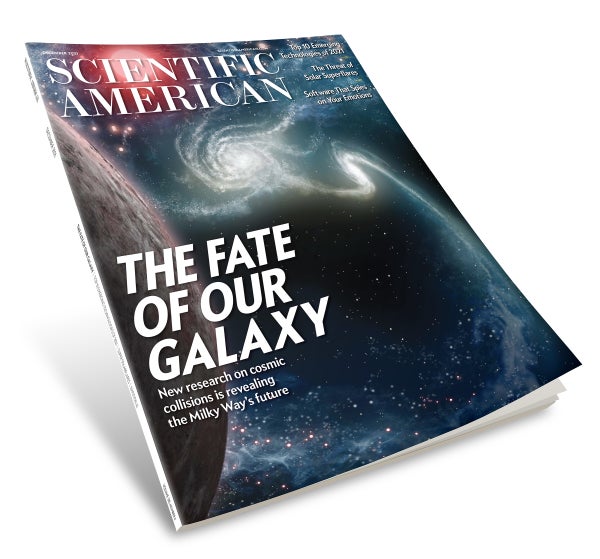What does the future hold? Ultimately that’s determined by gravity. Our Milky Way galaxy is destined to collide with our closest large neighbor, the Andromeda galaxy, in about five billion years. There’s no stopping it, but we can predict what’s going to happen, and thanks to powerful new telescopes, we can even watch previews by studying other galaxy mergers. In our cover story this month, astronomers Aaron S. Evans of the University of Virginia and Lee Armus of the California Institute of Technology foretell how our two galaxies will become one, creating energetic new star-forming regions and smashing their central black holes together in a burst of gravitational waves. We won’t be around to watch, but we will get a great view of other galaxies’ collisions (including a triple merger!) if the James Webb Space Telescope (JWST, which some astronomers call the Just Wonderful Space Telescope to focus on the space rather than the former NASA administrator) launches successfully in the next weeks or months.
Our sun will be a red giant by the time we merge with Andromeda, engulfing Mercury and Venus and then Earth as it grows to a diameter as large as Earth’s current orbit. But the sun can cause a lot of trouble for us well before that time, as space journalist Jonathan O’Callaghan explains. You may have heard of the Carrington Event, a massive geomagnetic storm in 1859 that fried telegraph lines. It and a similar solar eruption in 1921 were mostly curiosities in their times, but now they are recognized as warnings that a blast from the sun could cause catastrophic fires and meltdowns in our electrical infrastructure and satellite networks. That would be bad, but it could be worse: In 2012 scientists discovered a solar flare from the year 775 that was 10 or 100 times more energetic. Now researchers looking for odd isotopes in ice cores have found evidence for two more superflares, from 5259 and 7176 before the current era. Someday it’ll happen again, and we are not yet prepared.
If you’re reading about these ominous events within view of a surveillance camera, it might—well, so boosters claim—be able to pick up on any distress, engagement or amusement on your face. The field of “emotion AI” is moving quickly, and its applications are moving even faster, with marketers using the technology to gauge customer behavior and some companies using it to screen job applicants. But as with any artificial intelligence trained on human data sets, emotion and facial-recognition AI reinforce biases, as author John McQuaid writes. The research has brought new attention to the nature of emotion and whether human facial expressions are truly universal.
If you’ve been meaning to catch up on your health checkups (that’s on my to-do list), please read our Innovations In package about cancer screening to understand how and why this would be a good time to schedule an appointment. Colon cancer rates are going up in people younger than 50, and there are life-threatening racial and other disparities in access to all kinds of cancer screening. The COVID pandemic delayed regular tests for many people, and we’ll be seeing the consequences of those missed screenings for years to come.
This year marks our 10th collection of the Top 10 Emerging Technologies of the year, a collaboration run by Scientific American emerita editor in chief Mariette DiChristina with the World Economic Forum and a group of experts from around the world. It’s an inspiring collection, full of actionable ideas to fight climate change, improve food systems, treat diseases, and more. We’re looking forward to covering the successes of some of these technologies in the future.
